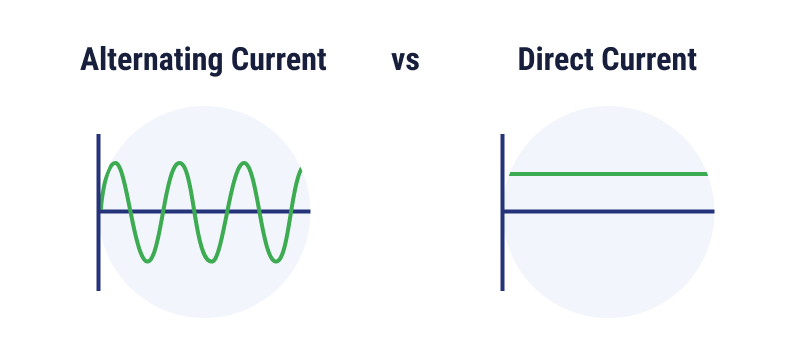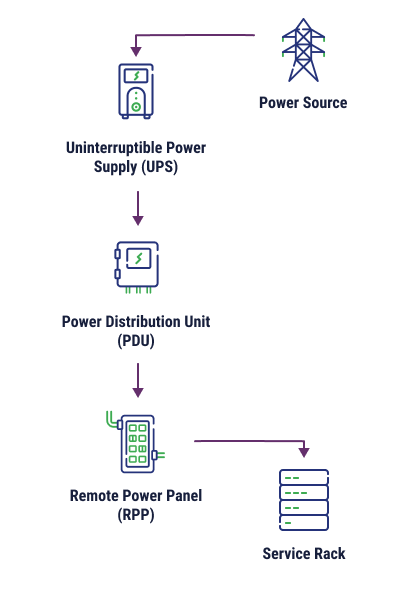November 16, 2023 | Matt Pacheco
Understanding Key Elements of Data Center Power Distribution

Power distribution is one of the most important considerations for a data center that is easy to take for granted. Generally, data center power distribution isn’t an issue until a moment of crisis – a power outage, extreme weather, or equipment failure, for example.
Understanding how a data center is powered, as well as what’s required to distribute the power, can help you make sense of the various configurations and equipment used to keep the lights on, and then some.
What is Power Distribution in a Data Center?
The delivery of electrical power from a power source to IT equipment is part of its power distribution system. To ensure availability and reliability, a power distribution system needs to be designed and supported so that it can deliver a power supply to all in-use IT equipment at all times.
The Importance of Power Distribution in Data Centers
The efficiency and reliability of data centers rely almost entirely on power distribution. If something is powered incorrectly and a part of the data center goes down, that can mean an interruption or complete stoppage of service for countless end users.
Cost of downtime varies based on the organization, but could range anywhere from $137 per minute to over $1 million per hour. Outside of the initial impact a disruption can cause, repeat outages can lead to a loss of trust and future revenue. Maintaining power distribution that works effectively for a data center is one easy way to significantly reduce the likelihood of downtime.
Types of Power Used By Data Centers
Data centers may use both alternating current (AC) and direct current (DC) power.

Alternating Current (AC)
Alternating current (AC) power changes direction 60 times per second at 60 Hz, which is why it’s called alternating. The grid delivers AC power to data centers and is used to power equipment like servers, networking equipment, storage devices, lighting, security systems, cooling systems, and other pieces of data center infrastructure.
Direct Current (DC)
Direct current (DC), unlike alternating current, flows in one direction. Power conversions and backup systems rely on this power. Microprocessors, uninterruptible power supplies (UPSs), and power distribution equipment can be powered via direct current.
While AC power is relatively inexpensive and easily available, DC power can be more efficient and reduce the energy consumption of data centers.
How is Power Distributed in Data Centers?
Starting with a main power source, power is distributed in data centers using medium-voltage and low-voltage distribution, with the final destination ending with server racks.

Power Source
The main power source for a data center normally comes from utility power from the grid. In cases of extreme weather or other disruptions, data centers may also use alternative data sources or generators.
Power is delivered to the data center from a utility company at a medium voltage level, such as 13.8 kV or 34.5 kV, but is then usually stepped down to a lower voltage level using transformers (480V or 208V).
Lower voltage power is then delivered to the data center via components via UPS, PDUs, and RPPs.
Uninterruptible Power Supply (UPS)
Power utility issues can be temporarily countered with an uninterruptible power supply (UPS). These devices offer battery backup to cover the time between the detection of utility issues and a generator starting.
Power Distribution Unit (PDU)
Individual IT equipment racks are served by power distribution units (PDUS) offering both metered and unmetered options. With metered PDUs, organizations can understand more about their power consumption, which enables them to begin taking steps toward optimizing their usage.
Remote Power Panel (RPP)
Remote power panels (RPPs) are the connectors between the PDUs and the individual IT devices. They can generally be found in the same rack as the IT equipment they are serving.
Server Rack
Finally, power in the data center reaches the server rack. IT equipment is mounted on these racks with power cords connecting them to PDUs.
Single-Phase vs. Three-Phase Power
Some important distinctions need to be made between single-phase and three-phase power to understand how power is distributed at data centers.
The most common type of power in small businesses and residential settings is single-phase power. With this system, there are two wires: a phase wire and a neutral wire. The power of this system is normally 120/240 V. In single-phase power, the phase wire carries the current and the neutral wire gives the current a path to return to the source.
Three-phase power, on the other hand, is more common in industrial or commercial settings, and is used most often by data centers. This system uses three phase wires, which are out of phase by 120 degrees from one another. Because the phases are different, the setup creates a more constant flow of power. Generally, the power from this system is either 208/120V or 480/277V. The even distribution between phase wires also reduces the heat generated by the system, making this power technique more efficient. With this type of power, servers consume power from one or two phases out of the three making the balancing of the power consumed within the rack critical to the uptime of the IT equipment.
Redundant Power Systems in Data Centers
For many businesses, continuous operation and little to no downtime isn’t a benefit, it’s a necessity. One of the ways data centers can facilitate this is through redundant power systems. Using generators, uninterruptible power supplies, and other devices, data centers may choose to employ redundant methods to maximize reliability and keep operations rolling.
Power System Redundancy Methods
- N Method: Say a system needs N components to operate. Enacting N-method redundancy means that an organization will have an extra redundant component above what is needed to be operational. This could be three generators for a data center that would require two to be powered.
- N+1 or N+X Redundancy: These are types of N-method redundancies. N+1 means data centers would have one additional component, whereas N+X may have more than one (X may be 2, 3, 4, and so on).
- 2N Redundancy: With 2N redundancy, twice as many components are available as are needed for meeting the load. If three generators are needed, six are available. This is also known as mirrored redundancy.
Choosing an Efficient and Reliable Data Center Provider
Part of choosing an efficient and reliable data center provider is understanding how power is distributed in their facility, and what redundancies they have in place to counter any potential disruptions. TierPoint’s data centers offer duplicates of critical components, such as power, as well as security and connectivity measures that promote maximum reliability. Learn more about how TierPoint can become a part of your data center strategy.
